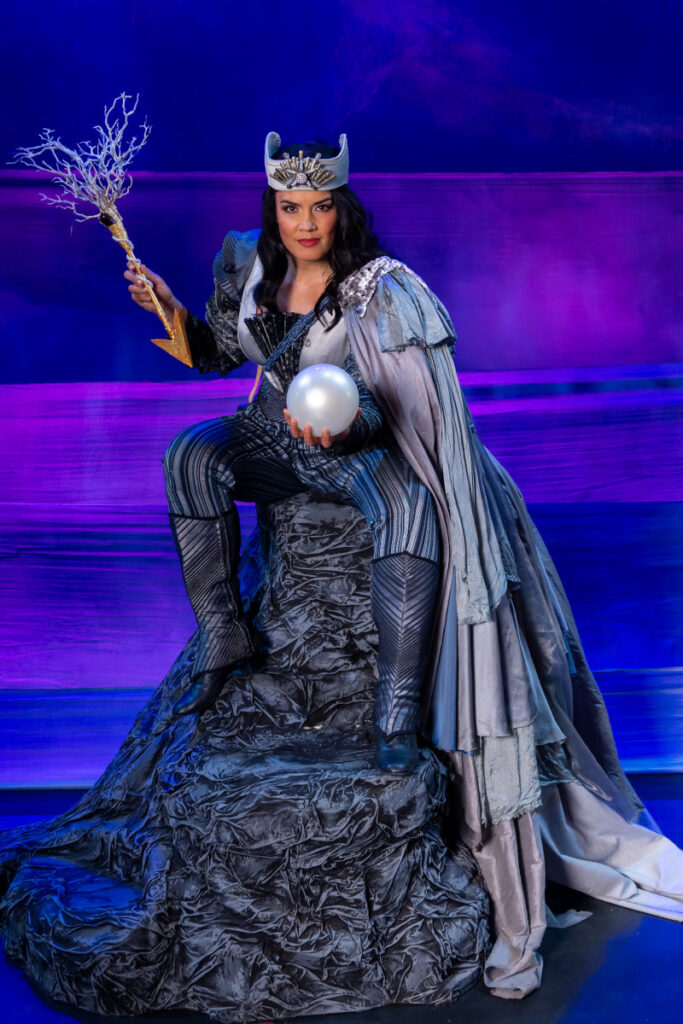How often do we see a fully staged performance of Purcell’s only opera where English music and French spectacle combine to such striking effect? If a production could be termed a stylistic entente cordiale, then this revival of Julien Lubek and Cécile Roussat’s staging at the Château de Versailles was memorable as much for its musical qualities as for its vividly imagined direction and classical-style costumes. This production brought together movement and music and, if not necessarily bearing kinship to pantomime, it could comfortably be labelled family entertainment. Picture book sets of colourful and witty invention occupied the stage where the iridescent blue of the Mediterranean was a constant presence along with rocky grottos, a gruesome sea monster and a Trojan ship. With much to feed the senses in this dreamlike realm, not least a trio of dancers and acrobats, one might have easily overlooked the work’s underlying tragedy, and its central theme of duty.

Believed to have been premiered at Josias Priest’s Boarding School for Girls, Chelsea in 1689, Dido and Aeneas relates the mythical tale of Aeneas, fleeing from the ruined city of Troy, and Dido, the queen of Carthage, whose love for the fugitive gradually develops. But malevolent gods and cunning sorceresses curtail the idyll and persuade Aeneas to sail for Rome. His obedience is taken by Dido as betrayal, and abandoned, she dies overcome by grief. The work’s closing scene is one of the most poignant of any opera, and while Dido’s celebrated Lament within this production was undoubtedly moving, any emotional trauma was, arguably, undermined by the unravelling of the expansive train of her dress – mimicking the motion of waves – that would gradually submerge her. As a coup de théâtre, it was certainly arresting, and fully in keeping with Lubek and Roussat’s fairy tale-like set design. Yet for all the delights afforded by the visual impact, its myriad diversions were out of kilter with the work’s solemnity. The Sorcerer appeared as a giant octopus furnished with swaying tentacles (redolent of The Little Shop of Horrors), an idea more amusing than unsettling. Elsewhere, witches with mermaid tails hung suspended in mid-air, Cupid sat high up on a crescent moon, while a plus-sized seashell carried the Queen of Carthage and her lover across the stage. It all seemed like an adolescent fantasy, but let’s not forget that Dido and Aeneas began life as a school play run by a dancing master.

If this revival echoed the tastes of 17th century audiences, it was supported by some impressive singing given by a young French cast with good, if not perfect, English diction. As Dido, Gaëlle Arquez was a noble queen, dignified in all her various encounters, possessing a voice that glowed from her opening torment to her closing lament. It’s a warm and even sounding mezzo that glows with an easy projection. My only caveat would be her articulation of the words ‘I am’ which to my ears came over as ‘I yam’. That aside, I look forward to hearing more of her in the future. Sarah Charles brought sparkle to the role of Belinda, ideal for recreating the youthful sound Purcell may have heard himself. The thankless role of Aeneas was well filled by rich-toned Anas Séguin, powerful in looks and voice. Attila Varga-Tóth was an admirable Sorcerer and sailor and supporting him were two well-matched witches in Pauline Gaillard & Camille-Taos Arbouz. The role of Spirit was sung with panache by Stéphane Wolf.

A chorus of 10 singers was tucked below stage with a 20 strong ensemble directed by Stefan Plewniak, who had created his own edition of Purcell’s score with music inserted from King Arthur and Dioclesian. Furthermore, Plewniak had added a trumpet sonata by Daniel Purcell and music by Matthew Locke, Purcell’s predecessor as Composer-in-Ordinary for the King’s Violins. Not content with a modest group of string and continuo players, the Orchestre de l’Opéra Royal comprised two recorders, an oboe and bassoon, a pair of theorbos, two harpsichords and percussion, this last including a thunder sheet of startling dimensions. And what fun the players had under Plewniak’s galvanising body language! Every muscle seemed pressed into service to bring out Purcell’s rhythmic drive, every attack galvanised. Yet he coaxed some wonderfully refined playing, its elegance of phrasing (distinctive for notes inégales) could have belonged to the music of Lully or Rameau with their stylish closing cadences. If French Baroque music speaks of the dance in all its guises, the Orchestre de l’Opéra Royal confirmed this unreservedly. And if, ultimately, this was Purcell in French clothes, its joie de vivre was compelling.
David Truslove
Didon et Énée
Music: Henry Purcell
Libretto: Nahum Tate drawn from Book IV of Virgil’s Aeneid
Cast & Production:
Dido – Gaëlle Arquez; Aeneas – Anas Séguin; Belinda – Sarah Charles; Sorcerer and a sailor – Attila Varga-Tóth; 1st and 2nd witches – Pauline Gaillard & Camille-Taos Arbouz; A spirit – Stéphane Wolf; Second Woman – Clara Penalva; Members of the Royal Opera Academy; Acrobats & dancers
Director, choreography, sets, costumes & lighting – Julien Lubek and Cécile Roussat; The Orchestre et le Choeur de l’Opéra Royal, Conductor – Stefan Plewniak
Château de Versailles, France, 16 November 2025
All photos © Franck Putigny